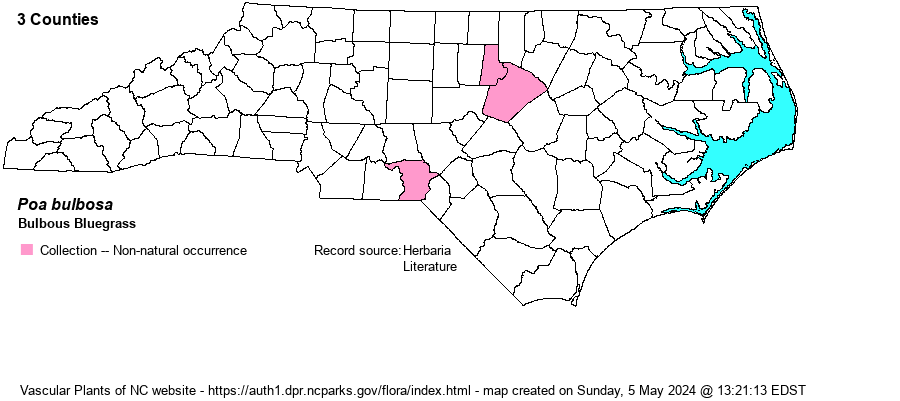| Author | L. | |
| Distribution | So far, 2 specimens of waifs have been seen: Durham County, dry rocky lawn weed in 1956; Richmond County, xeric lawn weed in 2000. Blomquist (1948) states that a collection was made from Raleigh, Wake County.
Native of Europe; in N.A. widespread except scarce in the middle and southern states. | |
| Abundance | Very rare, but probably overlooked. | |
| Habitat | Dry to xeric lawns. Introduced with seed mixes? | |
| Phenology | Flowering and fruiting March-May. | |
| Identification | This grass is readily told by the florets which are largely replaced by bulblike structures topped by slender, tapering, vegetative growths. The inflorescence thus looks like it has tiny slender leaves emanating from it. | |
| Taxonomic Comments | Our plants are ssp. vivipara.
The genus Poa contains some 500 species globally, about 70 in N.A. A typical Poa species has a number of basal leaves, few stem leaves, and a terminal, open inflorescence. The inflorescence is composed of well-spaced whorls of 2-6 skinny branches, usually with short side branchlets and these bearing spikelets. Branches may be strongly ascending, horizontal, or reflexed. Spikelets are composed of 2-6 florets and are generally laterally compressed. Each glume and lemma is acute to blunt, but seldom acuminate as in many Festuca species. Unlike Festuca and Bromus, most Poa species have a small wispy tuft of white hairs at the base of each floret. | |
| Other Common Name(s) | | |
| State Rank | SE | |
| Global Rank | GNR | |
| State Status | | |
| US Status | | |
| USACE-agcp | FACU link |
| USACE-emp | FACU link |

